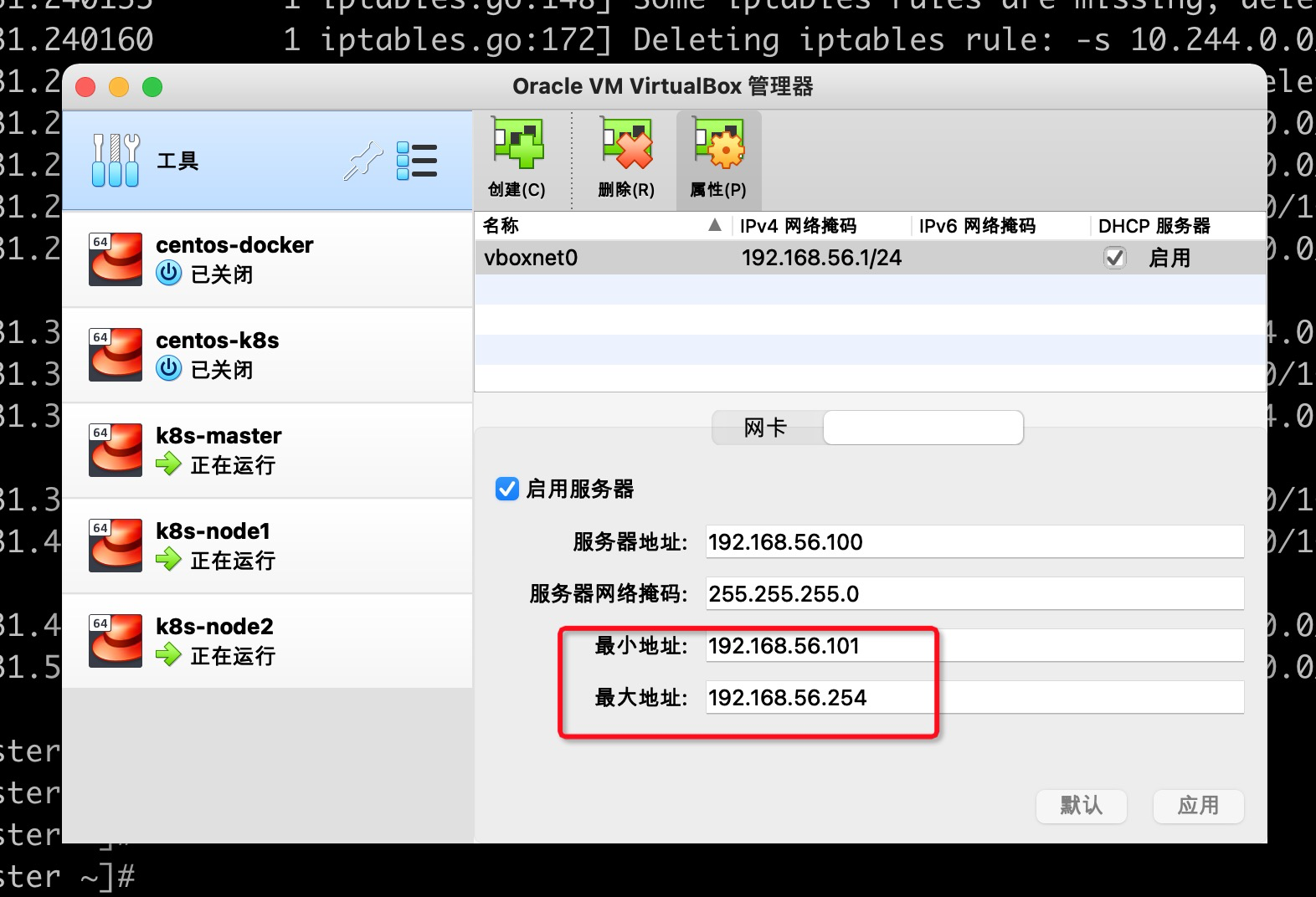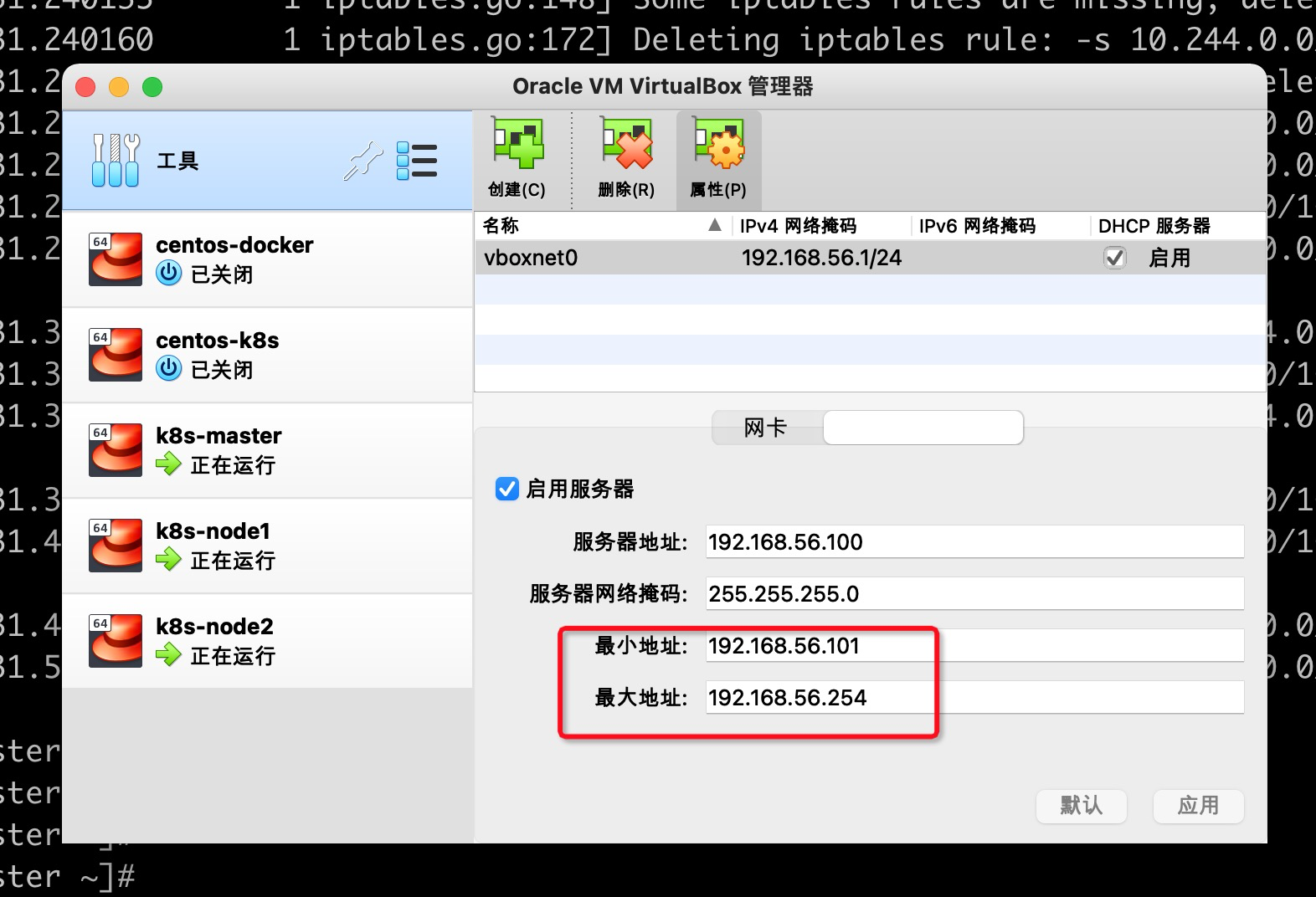k8s preliminary preparation
I mainly use it here docker-case Building local k8s(v1.21.2) clusters
Software preparation
- vagrant 2.2.16 Cross platform virtualization tools
- virtualbox Open source free virtual machine
- k8s version v1.21.2
vagrant environment description
- You need to use the root user to start the installation, otherwise you will encounter many problems
| node | Connection mode | password |
|---|---|---|
| master | ssh root@127.0.0.1 -p 2200 | vagrant |
| node1 | ssh root@127.0.0.1 -p 2201 | vagrant |
| node2 | ssh root@127.0.0.1 -p 2202 | vagrant |
Configuration process
Create three virtual machines first
Enter the directory and execute the following command: docker case / k8s
vagrant up
Modify images to Alibaba cloud
View the required version
kubeadm config images list
master starts installation
Using alicloud image acceleration, coredns: v1 8.0 can't download due to tag problem, so download coredns: v1.0 first eight
View the list of software to be installed
kubeadm config images list
Here we mainly look at the coredns version
k8s.gcr.io/kube-apiserver:v1.21.2 k8s.gcr.io/kube-controller-manager:v1.21.2 k8s.gcr.io/kube-scheduler:v1.21.2 k8s.gcr.io/kube-proxy:v1.21.2 k8s.gcr.io/pause:3.4.1 k8s.gcr.io/etcd:3.4.13-0 k8s.gcr.io/coredns/coredns:v1.8.0
Download coredns:1.8.0
docker pull registry.aliyuncs.com/google_containers/coredns:1.8.0
Replace tag
docker tag registry.aliyuncs.com/google_containers/coredns:1.8.0 registry.aliyuncs.com/google_containers/coredns:v1.8.0
Delete old
docker rmi registry.aliyuncs.com/google_containers/coredns:1.8.0
kubeadm init
kubeadm init \ --apiserver-advertise-address=192.168.56.200 \ --image-repository registry.aliyuncs.com/google_containers \ --kubernetes-version v1.21.2 \ --pod-network-cidr=10.244.0.0/16
Initialize kube
mkdir -p $HOME/.kube sudo cp -i /etc/kubernetes/admin.conf $HOME/.kube/config sudo chown $(id -u):$(id -g) $HOME/.kube/config sh -c "echo 'export KUBECONFIG=/etc/kubernetes/admin.conf' >> /etc/profile" source /etc/profile
Installing the network plug-in flannle
Since the ip(192.168.56.200) we used above is not on the eth0 network card, we need to modify the network card. You can view the network card through ip add
1. Download first
You can use it directly kube-flannel.yml
curl https://raw.githubusercontent.com/coreos/flannel/master/Documentation/kube-flannel.yml > kube-flannel.yml
2. Start editing VI Kube flannel yml
181 containers:
182 - name: kube-flannel
183 image: quay.io/coreos/flannel:v0.14.0
184 command:
185 - /opt/bin/flanneld
186 args:
187 - --ip-masq
188 - --kube-subnet-mgr
189 - --iface=eth1 # This place specifies the network card
3.apply flannel
[root@k8s-master ~]# kubectl apply -f kube-flannel.yml Warning: policy/v1beta1 PodSecurityPolicy is deprecated in v1.21+, unavailable in v1.25+ podsecuritypolicy.policy/psp.flannel.unprivileged created clusterrole.rbac.authorization.k8s.io/flannel created clusterrolebinding.rbac.authorization.k8s.io/flannel created serviceaccount/flannel created configmap/kube-flannel-cfg created daemonset.apps/kube-flannel-ds created
4. Verification results
Get pods first, and then view the log of a pod
[root@k8s-master ~]# kubectl get pods --all-namespaces NAMESPACE NAME READY STATUS RESTARTS AGE kube-system coredns-59d64cd4d4-2d46n 1/1 Running 0 19m kube-system coredns-59d64cd4d4-jvbvs 1/1 Running 0 19m kube-system etcd-k8s-master 1/1 Running 0 20m kube-system kube-apiserver-k8s-master 1/1 Running 0 20m kube-system kube-controller-manager-k8s-master 1/1 Running 0 15m kube-system kube-flannel-ds-hvsmm 1/1 Running 0 95s kube-system kube-flannel-ds-lhdpp 1/1 Running 0 95s kube-system kube-flannel-ds-nbxl4 1/1 Running 0 95s kube-system kube-proxy-6gj8p 1/1 Running 0 18m kube-system kube-proxy-jf8v6 1/1 Running 0 18m kube-system kube-proxy-srx5t 1/1 Running 0 19m kube-system kube-scheduler-k8s-master 1/1 Running 0 15m
From the log, you can see Using interface with name eth1 and address 192.168.56.200
[root@k8s-master ~]# kubectl logs -n kube-system kube-flannel-ds-nbxl4 I0709 08:28:28.858390 1 main.go:533] Using interface with name eth1 and address 192.168.56.200 I0709 08:28:28.859608 1 main.go:550] Defaulting external address to interface address (192.168.56.200) W0709 08:28:29.040955 1 client_config.go:608] Neither --kubeconfig nor --master was specified. Using the inClusterConfig. This might not work.
Using ipvs load balancing
What is ipvs You can see
28 iptables:
29 masqueradeAll: false
30 masqueradeBit: null
31 minSyncPeriod: 0s
32 syncPeriod: 0s
33 ipvs:
34 excludeCIDRs: null
35 minSyncPeriod: 0s
36 scheduler: ""
37 strictARP: false
38 syncPeriod: 0s
39 tcpFinTimeout: 0s
40 tcpTimeout: 0s
41 udpTimeout: 0s
42 kind: KubeProxyConfiguration
43 metricsBindAddress: ""
44 mode: "ipvs" # ipvs is specified here
45 nodePortAddresses: null
46 oomScoreAdj: null
Kubedm token reset
This step is not necessary. If the above join is forgotten, it can be regenerated
kubeadm token create --print-join-command
Possible problems
scheduler and controller manager ports do not work
[root@k8s-master ~]# kubectl get cs
Warning: v1 ComponentStatus is deprecated in v1.19+
NAME STATUS MESSAGE ERROR
scheduler Unhealthy Get "http://127.0.0.1:10251/healthz": dial tcp 127.0.0.1:10251: connect: connection refused
controller-manager Unhealthy Get "http://127.0.0.1:10252/healthz": dial tcp 127.0.0.1:10252: connect: connection refused
etcd-0 Healthy {"health":"true"}
solve
The main problem is -- port=0. Just comment it out
- vi /etc/kubernetes/manifests/kube-scheduler.yaml comment port
apiVersion: v1
kind: Pod
metadata:
creationTimestamp: null
labels:
component: kube-scheduler
tier: control-plane
name: kube-scheduler
namespace: kube-system
spec:
containers:
- command:
- kube-scheduler
- --authentication-kubeconfig=/etc/kubernetes/scheduler.conf
- --authorization-kubeconfig=/etc/kubernetes/scheduler.conf
- --bind-address=127.0.0.1
- --kubeconfig=/etc/kubernetes/scheduler.conf
- --leader-elect=true
# - --port=0 # Comment port
image: registry.aliyuncs.com/google_containers/kube-scheduler:v1.21.2
imagePullPolicy: IfNotPresent
livenessProbe:
failureThreshold: 8
httpGet:
host: 127.0.0.1
path: /healthz
port: 10259
scheme: HTTPS
.....
- vi /etc/kubernetes/manifests/kube-controller-manager.yaml also annotates ports
apiVersion: v1
kind: Pod
metadata:
creationTimestamp: null
labels:
component: kube-controller-manager
tier: control-plane
name: kube-controller-manager
namespace: kube-system
spec:
containers:
- command:
- kube-controller-manager
- --allocate-node-cidrs=true
- --authentication-kubeconfig=/etc/kubernetes/controller-manager.conf
- --authorization-kubeconfig=/etc/kubernetes/controller-manager.conf
- --bind-address=127.0.0.1
- --client-ca-file=/etc/kubernetes/pki/ca.crt
- --cluster-cidr=10.24.0.0/16
- --cluster-name=kubernetes
- --cluster-signing-cert-file=/etc/kubernetes/pki/ca.crt
- --cluster-signing-key-file=/etc/kubernetes/pki/ca.key
- --controllers=*,bootstrapsigner,tokencleaner
- --kubeconfig=/etc/kubernetes/controller-manager.conf
- --leader-elect=true
# - --port=0
- --requestheader-client-ca-file=/etc/kubernetes/pki/front-proxy-ca.crt
- --root-ca-file=/etc/kubernetes/pki/ca.crt
- --service-account-private-key-file=/etc/kubernetes/pki/sa.key
- --service-cluster-ip-range=10.96.0.0/12
- --use-service-account-credentials=true
image: registry.aliyuncs.com/google_containers/kube-controller-manager:v1.21.2
imagePullPolicy: IfNotPresent
livenessProbe:
failureThreshold: 8
httpGet:
host: 127.0.0.1
path: /healthz
port: 10257
scheme: HTTPS
.....
- Restart
systemctl restart kubelet.service
When kubedm joins, it is prompted that bridge NF call iptables is not closed
error execution phase preflight: [preflight] Some fatal errors occurred: [ERROR FileContent--proc-sys-net-bridge-bridge-nf-call-iptables]: /proc/sys/net/bridge/bridge-nf-call-iptables contents are not set to 1
solve
sudo sh -c " echo '1' > /proc/sys/net/bridge/bridge-nf-call-iptables"
Node cannot join the master node
The ip I used before is 192.168.56.100, which conflicts with the DHCP service of VirualBox. When selecting a port, you need to pay attention to the ip selection range

k8s preliminary preparation
I mainly use it here docker-case Building local k8s(v1.21.2) clusters
Software preparation
- vagrant 2.2.16 Cross platform virtualization tools
- virtualbox Open source free virtual machine
- k8s version v1.21.2
vagrant environment description
- You need to use the root user to start the installation, otherwise you will encounter many problems
| node | Connection mode | password |
|---|---|---|
| master | ssh root@127.0.0.1 -p 2200 | vagrant |
| node1 | ssh root@127.0.0.1 -p 2201 | vagrant |
| node2 | ssh root@127.0.0.1 -p 2202 | vagrant |
Configuration process
Create three virtual machines first
Enter the directory and execute the following command: docker case / k8s
vagrant up
Modify images to Alibaba cloud
View required version
kubeadm config images list
master starts installation
Using alicloud image acceleration, coredns: v1 8.0 can't download due to tag problem, so download coredns: v1.0 first eight
View the list of software to be installed
kubeadm config images list
Here we mainly look at the coredns version
k8s.gcr.io/kube-apiserver:v1.21.2 k8s.gcr.io/kube-controller-manager:v1.21.2 k8s.gcr.io/kube-scheduler:v1.21.2 k8s.gcr.io/kube-proxy:v1.21.2 k8s.gcr.io/pause:3.4.1 k8s.gcr.io/etcd:3.4.13-0 k8s.gcr.io/coredns/coredns:v1.8.0
Download coredns:1.8.0
docker pull registry.aliyuncs.com/google_containers/coredns:1.8.0
Replace tag
docker tag registry.aliyuncs.com/google_containers/coredns:1.8.0 registry.aliyuncs.com/google_containers/coredns:v1.8.0
Delete old
docker rmi registry.aliyuncs.com/google_containers/coredns:1.8.0
kubeadm init
kubeadm init \ --apiserver-advertise-address=192.168.56.200 \ --image-repository registry.aliyuncs.com/google_containers \ --kubernetes-version v1.21.2 \ --pod-network-cidr=10.244.0.0/16
Initialize kube
mkdir -p $HOME/.kube sudo cp -i /etc/kubernetes/admin.conf $HOME/.kube/config sudo chown $(id -u):$(id -g) $HOME/.kube/config sh -c "echo 'export KUBECONFIG=/etc/kubernetes/admin.conf' >> /etc/profile" source /etc/profile
Installing the network plug-in flannle
Since the ip(192.168.56.200) we used above is not on the eth0 network card, we need to modify the network card. You can view the network card through ip add
1. Download first
You can use it directly kube-flannel.yml
curl https://raw.githubusercontent.com/coreos/flannel/master/Documentation/kube-flannel.yml > kube-flannel.yml
2. Start editing VI Kube flannel yml
181 containers:
182 - name: kube-flannel
183 image: quay.io/coreos/flannel:v0.14.0
184 command:
185 - /opt/bin/flanneld
186 args:
187 - --ip-masq
188 - --kube-subnet-mgr
189 - --iface=eth1 # This place specifies the network card
3.apply flannel
[root@k8s-master ~]# kubectl apply -f kube-flannel.yml Warning: policy/v1beta1 PodSecurityPolicy is deprecated in v1.21+, unavailable in v1.25+ podsecuritypolicy.policy/psp.flannel.unprivileged created clusterrole.rbac.authorization.k8s.io/flannel created clusterrolebinding.rbac.authorization.k8s.io/flannel created serviceaccount/flannel created configmap/kube-flannel-cfg created daemonset.apps/kube-flannel-ds created
4. Verification results
Get pods first, and then view the log of a pod
[root@k8s-master ~]# kubectl get pods --all-namespaces NAMESPACE NAME READY STATUS RESTARTS AGE kube-system coredns-59d64cd4d4-2d46n 1/1 Running 0 19m kube-system coredns-59d64cd4d4-jvbvs 1/1 Running 0 19m kube-system etcd-k8s-master 1/1 Running 0 20m kube-system kube-apiserver-k8s-master 1/1 Running 0 20m kube-system kube-controller-manager-k8s-master 1/1 Running 0 15m kube-system kube-flannel-ds-hvsmm 1/1 Running 0 95s kube-system kube-flannel-ds-lhdpp 1/1 Running 0 95s kube-system kube-flannel-ds-nbxl4 1/1 Running 0 95s kube-system kube-proxy-6gj8p 1/1 Running 0 18m kube-system kube-proxy-jf8v6 1/1 Running 0 18m kube-system kube-proxy-srx5t 1/1 Running 0 19m kube-system kube-scheduler-k8s-master 1/1 Running 0 15m
From the log, you can see Using interface with name eth1 and address 192.168.56.200
[root@k8s-master ~]# kubectl logs -n kube-system kube-flannel-ds-nbxl4 I0709 08:28:28.858390 1 main.go:533] Using interface with name eth1 and address 192.168.56.200 I0709 08:28:28.859608 1 main.go:550] Defaulting external address to interface address (192.168.56.200) W0709 08:28:29.040955 1 client_config.go:608] Neither --kubeconfig nor --master was specified. Using the inClusterConfig. This might not work.
Using ipvs load balancing
What is ipvs You can see
28 iptables:
29 masqueradeAll: false
30 masqueradeBit: null
31 minSyncPeriod: 0s
32 syncPeriod: 0s
33 ipvs:
34 excludeCIDRs: null
35 minSyncPeriod: 0s
36 scheduler: ""
37 strictARP: false
38 syncPeriod: 0s
39 tcpFinTimeout: 0s
40 tcpTimeout: 0s
41 udpTimeout: 0s
42 kind: KubeProxyConfiguration
43 metricsBindAddress: ""
44 mode: "ipvs" # ipvs is specified here
45 nodePortAddresses: null
46 oomScoreAdj: null
Kubedm token reset
This step is not necessary. If the above join is forgotten, it can be regenerated
kubeadm token create --print-join-command
Possible problems
scheduler and controller manager ports do not work
[root@k8s-master ~]# kubectl get cs
Warning: v1 ComponentStatus is deprecated in v1.19+
NAME STATUS MESSAGE ERROR
scheduler Unhealthy Get "http://127.0.0.1:10251/healthz": dial tcp 127.0.0.1:10251: connect: connection refused
controller-manager Unhealthy Get "http://127.0.0.1:10252/healthz": dial tcp 127.0.0.1:10252: connect: connection refused
etcd-0 Healthy {"health":"true"}
solve
The main problem is -- port=0. Just comment it out
- vi /etc/kubernetes/manifests/kube-scheduler.yaml comment port
apiVersion: v1
kind: Pod
metadata:
creationTimestamp: null
labels:
component: kube-scheduler
tier: control-plane
name: kube-scheduler
namespace: kube-system
spec:
containers:
- command:
- kube-scheduler
- --authentication-kubeconfig=/etc/kubernetes/scheduler.conf
- --authorization-kubeconfig=/etc/kubernetes/scheduler.conf
- --bind-address=127.0.0.1
- --kubeconfig=/etc/kubernetes/scheduler.conf
- --leader-elect=true
# - --port=0 # Comment port
image: registry.aliyuncs.com/google_containers/kube-scheduler:v1.21.2
imagePullPolicy: IfNotPresent
livenessProbe:
failureThreshold: 8
httpGet:
host: 127.0.0.1
path: /healthz
port: 10259
scheme: HTTPS
.....
- vi /etc/kubernetes/manifests/kube-controller-manager.yaml also annotates ports
apiVersion: v1
kind: Pod
metadata:
creationTimestamp: null
labels:
component: kube-controller-manager
tier: control-plane
name: kube-controller-manager
namespace: kube-system
spec:
containers:
- command:
- kube-controller-manager
- --allocate-node-cidrs=true
- --authentication-kubeconfig=/etc/kubernetes/controller-manager.conf
- --authorization-kubeconfig=/etc/kubernetes/controller-manager.conf
- --bind-address=127.0.0.1
- --client-ca-file=/etc/kubernetes/pki/ca.crt
- --cluster-cidr=10.24.0.0/16
- --cluster-name=kubernetes
- --cluster-signing-cert-file=/etc/kubernetes/pki/ca.crt
- --cluster-signing-key-file=/etc/kubernetes/pki/ca.key
- --controllers=*,bootstrapsigner,tokencleaner
- --kubeconfig=/etc/kubernetes/controller-manager.conf
- --leader-elect=true
# - --port=0
- --requestheader-client-ca-file=/etc/kubernetes/pki/front-proxy-ca.crt
- --root-ca-file=/etc/kubernetes/pki/ca.crt
- --service-account-private-key-file=/etc/kubernetes/pki/sa.key
- --service-cluster-ip-range=10.96.0.0/12
- --use-service-account-credentials=true
image: registry.aliyuncs.com/google_containers/kube-controller-manager:v1.21.2
imagePullPolicy: IfNotPresent
livenessProbe:
failureThreshold: 8
httpGet:
host: 127.0.0.1
path: /healthz
port: 10257
scheme: HTTPS
.....
- Restart
systemctl restart kubelet.service
When kubedm joins, it is prompted that bridge NF call iptables is not closed
error execution phase preflight: [preflight] Some fatal errors occurred: [ERROR FileContent--proc-sys-net-bridge-bridge-nf-call-iptables]: /proc/sys/net/bridge/bridge-nf-call-iptables contents are not set to 1
solve
sudo sh -c " echo '1' > /proc/sys/net/bridge/bridge-nf-call-iptables"
Node cannot join the master node
The ip I used before is 192.168.56.100, which conflicts with the DHCP service of VirualBox. When selecting a port, you need to pay attention to the ip selection range
